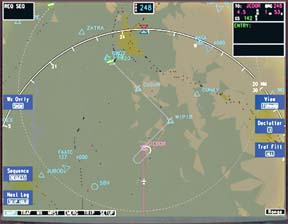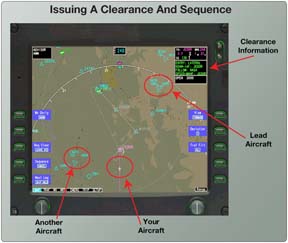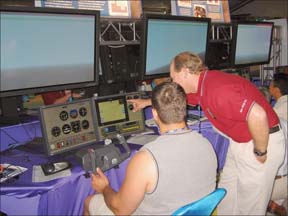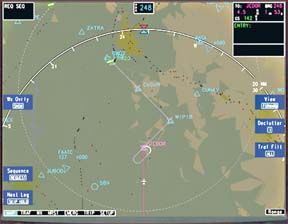
By Thomas P. Turner
November 329PT, youre number five for the approach. Fly direct to Reece intersection and hold as published, maintain 4000, expect approach clearance at 20 past the hour; time now 35 past the hour.
That kind of lengthy, delayed approach clearance could become commonplace in the near future. Oh, sure; a few things have to happen first. Like very light jets (VLJs) populating the skies per projections. And the traveling public-which refers to regional jets as little airplanes-must accept six-seaters as safe, viable transportation. Then, the FAA/NASA vision of light airplanes replacing regional highway traffic in the Small Airplane Transportation System (SATS) will have to become a reality. Reliever airports must begin to accept a significantly greater number of passenger-mile traffic from airline hubs. And the production of Adams and Cirrus and Diamond and Eclipse and all the other new and legacy manufacturers must be sufficient to reverse the trend of a shrinking owner-flown aircraft fleet.
If all of these things come to pass-a whole lot of ifs-then clearances sounding like Constellations and DC-6s stacking up over Idewild in 1959 may become increasingly common in our future. How it all will work and what it could mean to you was recently demonstrated to the public and I was able to participate and ask a few questions about one vision-NASAs-of the ATC system of tomorrow.
SATS and HVO
The SATS research program was designed to envision and demonstrate technologies to harness the unused capacity of the National Airspace System (NAS). Research united NASA, the FAA, universities and industry in a five-year study. Key to SATS is the promotion of small aircraft utilization and increased service to areas that have not traditionally received attention from scheduled (air) carriers. Foreseeing the gridlock-causing events described above if SATS is successful-and perhaps even if it isnt-the research included efforts to better integrate small aircraft operation into the NAS. A vital element of the SATS program, then, was a means to dramatically increase the capacity of airports, especially in an IFR environment.
Ever keen to coin new acronyms, SATS researchers attacked the enter the hold problem with a concept called HVO-short for High Volume Operations. The HVO concept encompasses several complementary (and sometimes competing) technologies to dramatically increase airport capacity by making it possible for several airplanes to share the approach course and missed approach corridors at the same time.
To explain, lets back up a bit. Currently, in a radar environment ATC can increase capacity by pushing tin within tight horizontal and vertical limits. Seeing all on a radar screen, the controller issues instructions and, using judgment and experience, gets the maximum number of airplanes through the approach in the shortest time.
In a non-radar environment, or in the case of a radar failure, controllers do this all in their head and on paper, in part by issuing clearance limits and requiring pilot position reports. As an increased safety margin, the horizontal and sometimes the vertical separation limits are necessarily greater. The end result is that capacity is reduced and it takes longer to get everyone down.
Now, move out to a non-towered airport away from radar coverage. Often, the missed approach procedure routes the airplane back to the final approach fix for holding. In that case, or in any situation where the missed approach path comes near the inbound course below the minimum vectoring altitude, controllers will have to stack inbounds in holds or at higher altitudes until receiving positive verification that the preceding airplane has landed.The result in almost all cases at non-towered airports is that only one airplane can be cleared for the approach at a time; the next flight cannot be cleared for an approach until the preceeding one cancels IFR. In practice, this means three to four approaches can be shot per hour…greatly curtailing airport capacity.
Back to HVO: To enable radar controller-like spacing and vectoring available at non-towered airports out of direct ATC radar coverage, HVO puts approach monitoring and sequencing into the cockpit. Many sources have dubbed these pilot-sequenced approaches.
Some would applaud making pilots responsible for separation and sequence. In fact, HVO depends on robotic technologies controlling pilots through two-way radio links to the ground and instructions displayed on Multi-Function Displays (MFDs) in the airplane. The resulting technology promises to permit as many as five airplanes on the approach at a time with multiple missed approach options, for a total of 15 to 20 approaches per hour at non-towered airports-enough capacity to satisfy the most optimistic SATS dreamer. So, how might the HVO concept work, if it is implemented?
How It Works
First, understand that HVO will require some additional ground-based and airborne equipment. Some brief descriptions can be found in the sidebar on the next page. Heres how it might work.
Inbound for the HVO airport, youre handled conventionally by ATC until some 30 miles out. At that point, ATC clears you to an initial approach fix and to enter the Self Controlled Area (SCA). This is your cue to activate the aircrafts HVO equipment and verify automated two-way communication between your onboard processor and the AMM. At this point you sign off with ATC and, although still under IFR, contact the airports CTAF (Common Traffic Advisory Frequency).
Your MFD display looks like pictured above. A box in the upper left, as well as a blue box second from the bottom on the left, provide information on the status of your clearance. A magenta line shows your clearance direct to the IAF (in this case, Jedor), and depicts a holding pattern to expect if youre not cleared further. Other participating airplanes are indicated by chevrons (looking eerily like surplus from a game of Asteroids) with data blocks listing their call sign, groundspeed and altitude relative to your airplane. The box in the upper right, just beneath navigation, speed and ETA data displays additional data about the status of your clearance.

The AMM (see below), is expecting you and quickly plots your position, altitude and groundspeed, comparing your data with other HVO aircraft in the area. It then sequences you for the approach. Again refer to the MFD screen above: The box in the upper left verifies communication with the AMM. Further down the left side of the MFD, you see you are cleared to leave ATC and continue under AMM direction. Your next ATC-type action will be to cancel IFR, and you will be permitted to skip (the) hold and proceed onward from Jedor. In the upper right below the nav data you see youve been granted a lateral entry-meaning you should maintain your altitude once past Jedor.If youre above the published altitude and commanded to descend once past Jedor, this block will specify a vertical entry.
The second line of the instructions block confirms youre inbound to Danville, Va. (DAN), by way of Jedor intersection, and that you are to follow the airplane with the NASA callsign, depicted with a double-line chevron, beginning the approach on the other side of the GPS T. Your assigned MAHF (Missed Approach Holding Fix), should you need it, is Jedor, and a dashed line on the display shows you your individualized missed approach course.
From here you fly the published GPS approach. The difference is that the NASA plane will be ahead of you, and other aircraft may join the approach from either direction, while youre still inbound. Once in-trail, if you are closing on the preceding aircraft so as to violate minimum lateral separation requirements, its chevron symbol will turn red, prompting you to slow down.If you near minimum separation the other airplanes red chevron will flash, requiring more aggressive action on your part. In a sense, the AMM commands and MFD symbols allow VFR-style see and avoid tactics in IMC. Got all that?
Flying the HVO Approach
Part of the SATS demonstration event included the opportunity to experience the HVO approach. A bank of PC-driven flight simulators staffed by NASA and industry SATS developers was linked together so we could all fly in toward the same airport at the same time and thus experience the AMM-driven system.
I started the approach from about 20 miles out, and it performed as advertised. Since I was high and fairly close behind another participant (at the controls somewhere else in the computer bank), the unit commanded me to fly direct to Jedor and enter the hold for a vertical, or descending approach. I nudged the joystick to swing my airplane symbol around the magenta holding track, pulling some power to descend to approach altitude.
About ready to turn inbound in the hold, the MFD flashed permission to begin the approach, following the preceding airplane (which was beginning to turn onto the final approach course). A third airplane was coming head-on, flying the GPS T from the other direction. I asked my NASA instructor how Id avoid that airplane, as its pilot was slowing down (as indicated by its ground speed readout) and I wasnt sure we wouldnt meet when it was time for me to turn inbound. Sure enough, the other airplanes chevron began to glow red. Meanwhile, a fourth airplane had entered the hold at Jedor behind me, no doubt watching her MFD for direction to proceed inbound. I was suddenly in very busy airspace. My NASA guide suggested I slow down also (I was already at my approach speed), and see what happens. The short version is that the airplane ahead of me continued to slow to the point his red chevron was flashing, meaning we were near or violating separation minimums. Although the sequencing part of the demonstration worked great, clearly there is need for solving some issues about approach speeds and separation before this experimental technology becomes operational.
What About Safety?
Its hard for me to look at something new in aviation and not put on my safety hat. I like to think about possible gotchas in new technology and procedures, to anticipate how to teach the new operation and help pilots make good decisions. That way we can safely benefit from the advance in technology. Based on my too-short exposure to HVO, here are some safety-related items for developers and pilots to think about:
See and Avoid: The HVO concept incorporates a sort of see-and-avoid capability for participating aircraft. This means that rules must be created for evasive action, breaking off the approach and rejoining the approach once clear of traffic. In visual or marginal conditions (or when the underlying Class G airspace may include scud-runners) the head-in-the-cockpit technology of HVO may distract pilots from their primary duty to look outside to avoid collisions.
Participating traffic: Separation and sequencing with the AMM assumes that all aircraft in the SCA are participating in the service. This potentially means no VFR operations within 30 miles of AMM-equipped airports, and a significant level of technology investment required to operate under Special VFR or IFR in this system. During my demonstration flight at the SATS conference, in fact, one computer-pilot was transiting the area and registered as a threat while I was inbound on the final approach course. It was unclear how I was expected to maneuver to avoid it while under robotic sequence control.
Groundspeeds: The AMM sequencing is based on groundspeed on detection within the SCA. As I saw in my flight, slowing down after sequence is established can throw a wrench in the works. The absurd conclusion is that pilots should slow to and maintain their selected approach speed from prior to entering the 30-mile SCA to the missed approach point. An alternative might be for a mandatory speed to be assigned for each segment of the approach, perhaps with a different mandatory speed matching the capabilities of various aircraft designs.
Inconsiderate Pilots: Youve got to expect that some idiot will decide that the system will warn others if they get too close means and cut in line out of sequence. When under the control of an authority, be it ATC or an AMM, theres a natural tendency for pilots to feel traffic-complacent.This could be disastrous if someone believes the rules dont apply to them.
Equipment Outages: In addition to existing lost-comm procedures for IFR airplanes, introduction of HVO would require strict rules for lost nav, lost transponder and lost processor scenarios (which would prevent the exchange of data with the AMM).

IFR Departures: Have you ever sat on the ground waiting for departure clearance when IFR airplanes were inbound for the approach? In the world of HVO, its possible a constant string of inbounds could prevent IFR departures indefinitely. I specifically asked one of the HVO designers if the AMM would have some way of holding arrivals to allow an IFR departure. The designer responded that they did not envision a lot of IFR departures.
Controllers and Security: During the demonstration event, there was talk among designers that controllers oppose relinquishing huge blocks of airspace to robotic control and, even if they werent, national security interests would not permit a perceived reduction in Federal oversight of aviation operations. There are therefore strong political overtones to introduction of anything approximating HVO.
Mr. Roboto, Phone Home
The jurys still out on whether the SATS vision will succeed-in fact, the case has only now entered discovery, with evidence being collected.Whether SATS becomes reality or not, the program spin-offs-greatly increased capacity at non-towered airports, and eliminating long holds and EFC times-may change the way we fly in coming years.
Am I an aeronautical Luddite, hopelessly opposed to HVO? Absolutely not.Im frankly quite impressed with this admittedly experimental, demonstration-only-for-now-at-least system. Yet, there are a lot of bugs to work out and a number of safety concerns to resolve before we can routinely fly self-sequenced approaches under the guise of robotic (versus ATC) control.
Also With This Article
“What Is SATS?”
“Equipping For HVO”
-Tom Turner is a CFII-MEI who frequently writes and lectures on aviation safety.




